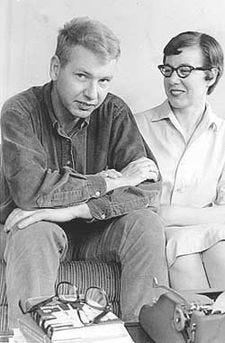Book vs Movie: The Hustler
“The Hustler” was written by Walter Tevis and published in 1959 to a good critical response and with Tevis being compared favorably to Hemingway. “The Hustler” quickly made its way to Hollywood with a film version was released in September 1961.

“The Hustler” is the story of Eddie Felson, a small time California hustler who hustles his way cross country with his manager and bank roll Charlie until they arrive in Chicago where Eddie wants to play the best pool player in the country, Minnesota Fats. Eddie gets his game and although he comes close, ends up losing to Fats. Leaving Charlie behind, Eddie wanders Chicago ending up in a bus station and meeting Sarah, an alcoholic who takes Eddie in. She nurses his spirit through his loss, and when he hustles the wrong people in the wrong bar and they break his thumbs she nurses his body too. He meets Bert a professional gambler who takes Eddie under his wing to teach him how to be a “winner,” and lead him back for a rematch with Minnesota Fats.
Tevis’ novel is a richly written book, the prose is sepia tinged as it should be for the world and subject the author is bringing to the reader. His description of character and place is very vivid. The scene in which Eddie gets his thumbs broken is a much more visceral experience in the book than its portrayed in the movie. The writing is especially florid when Eddie first plays Minnesota Fats “…the right hand holding the butt delicately, much as a violinist holds his bow — gracefully but surely.” Also this, “And then Fats began moving around the table, making balls, all of his former ponderousness gone now, his motions like a ballet, the step light, sure and rehearsed…” Prose the filmmakers paraphrased in the movie.
One of the shortcomings of Tevis’ novel is the symbolism seems obvious. Such as Sarah’s childhood polio that twists one of her legs and Tevis repeatedly reinforces that description of Sarah throughout the book. Another scene, that was left out of the movie probably for this exact reason is during a game a bug is crawling across a pool table and a players squashes it with the butt of the pool cue.
The novel’s ending is more ambiguous than the movie’s. In the novel Eddie is left in limbo with his relationship with Sarah, and with Bert, leaving the question does Bert have his hooks deep enough into Eddie to have him being a virtual slave shooting pool for Bert until he’s no longer a winner. This ending of purgatory for “the best” is a starting point for the “Twilight Zone” episode “A Game of Pool” in which a champion pool player has to spend his after-life in purgatory playing all comers until he’s released by someone who is the better player.
The movie follows the book fairly closely. It was shot in black and white and with a jazz soundtrack that feels very noir and has the sepia tone needed for smoky poolrooms, with small time hustlers, gamblers, and those on the downside of life. There is a temptation to think the character of Eddie Felson was written for Paul Newman as Eddie is frequently described as having a charismatic smile, something that Newman was known for (this is also the case in the novel of “Cool Hand Luke” who is described as having a charming smile). The biggest departure is the resolution of Sarah’s and Bert’s characters. In the movie Sarah, as written and as played by Piper Laurie is a more tragic figure than the book. She’s an alcoholic (as she is in the book), but seems more on the edge in the movie. She tells Eddie she lies about things when she’s drunk and that a rich old man pays for her apartment, she seems to need Eddie more in the movie than Tevis’s novel. When she is driven to suicide in Kentucky it adds a complexity not present in the novel. This serves to increase the tension between Eddie and Bert in the conclusion of the movie when Eddie is playing Minnesota Fats for the second time, and Bert demands his cut of Eddie’s winnings. It’s a more tense scene because Sarah’s life is between them, and it gives the scene a greater sense of existential immediacy than the book, and gives Eddie a way out from under Bert‘s thumb. The movie’s conclusion seems to make more sense then the novel’s.
I think that in the case of “The Hustler” it’s a toss-up on which is better the movie or the book. I enjoyed them equally, perhaps for different reasons because of the nature of the medium involved in delivering the story.
Fact I didn’t know before: That Walter Tevis invented the character of Minnesota Fats. It wasn’t until after the movie was released that pool hustler Rudolf Wanderone renamed himself Minnesota Fats (at one time in his life going by the moniker of New York Fats) and started giving interviews that the character was based on him. It lead to some lucrative endorsement deals from billiard companies and book deals.






No comments:
Post a Comment